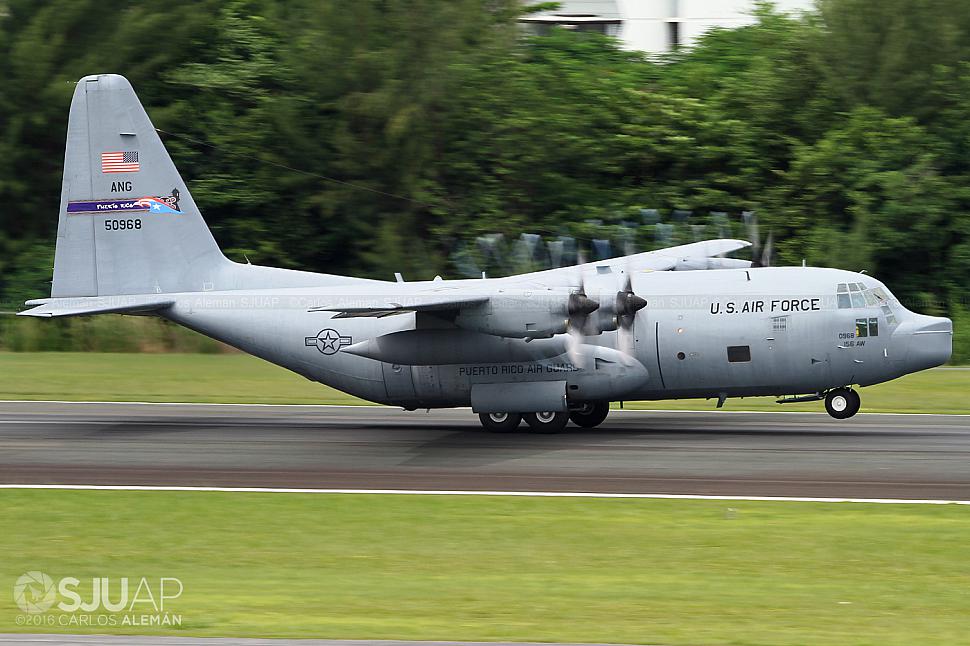C-130 News
C-130 Hercules News
PRANG WC-130 crash investigation results released
November 9, 2018 (by
Asif Shamim) -
Air Mobility Command released the results of its investigation into the WC-130H Hercules crash near Savannah/Hilton Head International Airport, Savannah, Georgia, May 2, that killed all nine Airmen on board.

The aircraft crew, assigned to the 156th Airlift Wing, Muñiz Air National Guard Base, Puerto Rico, was on a mission to deliver the aircraft from Savannah/Hilton Head Airport to the 309th Aerospace Maintenance and Regeneration Group at Davis-Monthan Air Force Base, Arizona.
While rolling down the runway, during initial takeoff, the left outermost engine, also referred to as the number one engine, experienced significant decay in RPMs and torque which substantially lowered thrust (the force which moves the aircraft through the air).
The thrust deficiency went unrecognized by the crew until moments before liftoff when the aircraft veered left and nearly departed the runway into the grass before achieving flight. Upon initial ascent, the mishap crew failed to properly apply normal and emergency procedures to address the situation, including improper application of left rudder and making a left turn in the direction of the failed engine.
The improper application of a left rudder resulted in a left-wing stall. The aircraft descended and impacted the terrain on Georgia State Highway 21. No bystanders were harmed by the crash.
The Accident Investigation Board team, led by Brig. Gen. John C. Millard, Deputy Director, AMC Strategic Plans, Requirements, and Programs, determined the crew's management of the malfunction deviated from standard procedures and technical orders.
Ultimately, after an extensive engineering and human factors analysis it was identified by a preponderance of the evidence the cause of the accident was pilot error. Failure to follow procedures and checklists placed the aircraft in a dangerous flight position and vulnerable to an errant rudder input. The subsequent application of left rudder by the pilot resulted in the loss of aircraft control and ultimate aircraft mishap.
Substantial contributing factors to the mishap include the crew's failure to adequately prepare for emergency actions, discontinue the takeoff, properly execute appropriate after-takeoff and engine shutdown checklists and procedures; and ground maintenance before the mission failed to properly diagnose and repair the malfunction with engine one which reoccurred during takeoff on the mishap flight.
"The purpose of the investigation was to identify the cause and contributing factors that led to this tragic and unfortunate incident," Millard said. "By conducting a thorough review and investigation, we hope to provide answers to the families of brave Airmen that lost their lives and prevent future occurrences and tragedies."
Millard led a Total Force team of multi-disciplinary subject matter experts from June 18-July 16 to assess the facts and circumstances of the crash and determine its cause. The team relied on multiple sources including interviews, logs, video, briefing materials and inspection of aircraft wreckage. After an extensive engineering and human factors analysis, the team assembled a detailed sequence of events surrounding the WC-130H's crash to determine accident cause.

USAF C-130H #65-0968 from the 198th AS is seen landing at Luis Muñoz Marín International Airport on October 8, 2016. [Photo by Carlos Aleman]
While rolling down the runway, during initial takeoff, the left outermost engine, also referred to as the number one engine, experienced significant decay in RPMs and torque which substantially lowered thrust (the force which moves the aircraft through the air).
The thrust deficiency went unrecognized by the crew until moments before liftoff when the aircraft veered left and nearly departed the runway into the grass before achieving flight. Upon initial ascent, the mishap crew failed to properly apply normal and emergency procedures to address the situation, including improper application of left rudder and making a left turn in the direction of the failed engine.
The improper application of a left rudder resulted in a left-wing stall. The aircraft descended and impacted the terrain on Georgia State Highway 21. No bystanders were harmed by the crash.
The Accident Investigation Board team, led by Brig. Gen. John C. Millard, Deputy Director, AMC Strategic Plans, Requirements, and Programs, determined the crew's management of the malfunction deviated from standard procedures and technical orders.
Ultimately, after an extensive engineering and human factors analysis it was identified by a preponderance of the evidence the cause of the accident was pilot error. Failure to follow procedures and checklists placed the aircraft in a dangerous flight position and vulnerable to an errant rudder input. The subsequent application of left rudder by the pilot resulted in the loss of aircraft control and ultimate aircraft mishap.
Substantial contributing factors to the mishap include the crew's failure to adequately prepare for emergency actions, discontinue the takeoff, properly execute appropriate after-takeoff and engine shutdown checklists and procedures; and ground maintenance before the mission failed to properly diagnose and repair the malfunction with engine one which reoccurred during takeoff on the mishap flight.
"The purpose of the investigation was to identify the cause and contributing factors that led to this tragic and unfortunate incident," Millard said. "By conducting a thorough review and investigation, we hope to provide answers to the families of brave Airmen that lost their lives and prevent future occurrences and tragedies."
Millard led a Total Force team of multi-disciplinary subject matter experts from June 18-July 16 to assess the facts and circumstances of the crash and determine its cause. The team relied on multiple sources including interviews, logs, video, briefing materials and inspection of aircraft wreckage. After an extensive engineering and human factors analysis, the team assembled a detailed sequence of events surrounding the WC-130H's crash to determine accident cause.
Courtesy of Headquarters Air Mobility Command Public Affairs
Related articles:
External link:
Forum discussion:
Tags
External link:
- Full Report ( PDF)
Forum discussion:
- Start a discussion about this article in the C-130.net forum.
Tags
